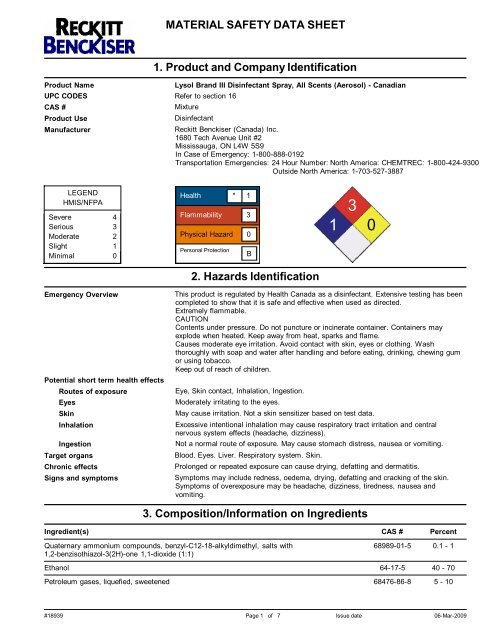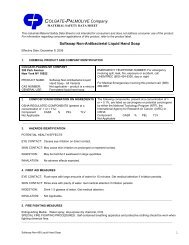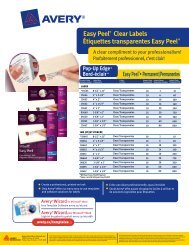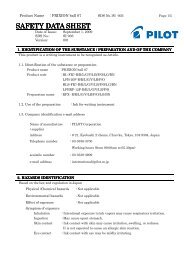Lysol Disinfectant Spray (All Scents) - Arctic Catering
Lysol Disinfectant Spray (All Scents) - Arctic Catering
Lysol Disinfectant Spray (All Scents) - Arctic Catering
Create successful ePaper yourself
Turn your PDF publications into a flip-book with our unique Google optimized e-Paper software.
.<br />
.<br />
.<br />
MATERIAL SAFETY DATA SHEET<br />
1. Product and Company Identification<br />
space<br />
Product Name<br />
<strong>Lysol</strong> Brand III <strong>Disinfectant</strong> <strong>Spray</strong>, <strong>All</strong> <strong>Scents</strong> (Aerosol) - Canadian<br />
space<br />
UPC CODES Refer to section 16<br />
space<br />
CAS #<br />
space<br />
Product Use<br />
space<br />
Manufacturer<br />
Mixture<br />
<strong>Disinfectant</strong><br />
Reckitt Benckiser (Canada) Inc.<br />
1680 Tech Avenue Unit #2<br />
Mississauga, ON L4W 5S9<br />
In Case of Emergency: 1-800-888-0192<br />
Transportation Emergencies: 24 Hour Number: North America: CHEMTREC: 1-800-424-9300<br />
Outside North America: 1-703-527-3887<br />
space<br />
LEGEND<br />
HMIS/NFPA<br />
Severe<br />
Serious<br />
4<br />
3<br />
Moderate 2<br />
Slight 1<br />
Minimal 0<br />
Health * 1<br />
Flammability 3<br />
Physical Hazard 0<br />
Personal Protection<br />
B<br />
2. Hazards Identification<br />
3<br />
1 0<br />
space<br />
Emergency Overview<br />
space<br />
Potential short term health effects<br />
Routes of exposure<br />
space<br />
space<br />
space<br />
space<br />
Eyes<br />
Skin<br />
Inhalation<br />
Ingestion<br />
space<br />
Target organs<br />
space<br />
Chronic effects<br />
space<br />
Signs and symptoms<br />
This product is regulated by Health Canada as a disinfectant. Extensive testing has been<br />
completed to show that it is safe and effective when used as directed.<br />
Extremely flammable.<br />
CAUTION<br />
Contents under pressure. Do not puncture or incinerate container. Containers may<br />
explode when heated. Keep away from heat, sparks and flame.<br />
Causes moderate eye irritation. Avoid contact with skin, eyes or clothing. Wash<br />
thoroughly with soap and water after handling and before eating, drinking, chewing gum<br />
or using tobacco.<br />
Keep out of reach of children.<br />
Eye, Skin contact, Inhalation, Ingestion.<br />
Moderately irritating to the eyes.<br />
May cause irritation. Not a skin sensitizer based on test data.<br />
Excessive intentional inhalation may cause respiratory tract irritation and central<br />
nervous system effects (headache, dizziness).<br />
Not a normal route of exposure. May cause stomach distress, nausea or vomiting.<br />
Blood. Eyes. Liver. Respiratory system. Skin.<br />
Prolonged or repeated exposure can cause drying, defatting and dermatitis.<br />
Symptoms may include redness, oedema, drying, defatting and cracking of the skin.<br />
Symptoms of overexposure may be headache, dizziness, tiredness, nausea and<br />
vomiting.<br />
3. Composition/Information on Ingredients<br />
space<br />
Ingredient(s)<br />
Quaternary ammonium compounds, benzyl-C12-18-alkyldimethyl, salts with<br />
1,2-benzisothiazol-3(2H)-one 1,1-dioxide (1:1)<br />
Ethanol<br />
Petroleum gases, liquefied, sweetened<br />
CAS #<br />
68989-01-5<br />
64-17-5<br />
68476-86-8<br />
Percent<br />
0.1 - 1<br />
40 - 70<br />
5 - 10<br />
#18939 Page 1 of 7 Issue date 06-Mar-2009
.<br />
.<br />
.<br />
.<br />
space<br />
First aid procedures<br />
Eye contact<br />
space<br />
space<br />
space<br />
space<br />
Skin contact<br />
Inhalation<br />
Ingestion<br />
Notes to physician<br />
space<br />
General advice<br />
4. First Aid Measures<br />
Hold eye open and rinse slowly and gently with water for 15-20 minutes. Remove<br />
contact lenses, if present, after the first 5 minutes, then continue rinsing eye. Call a<br />
poison control center or doctor for treatment advice.<br />
Immediately flush with cool water for 15 minutes while removing contaminated clothing<br />
and shoes. Discard or wash well before reuse. Obtain medical attention if irritation<br />
persists.<br />
Move victim to fresh air. If symptoms persist, obtain medical attention.<br />
Call a physician or Poison Control Centre immediately. Have victim rinse mouth<br />
thoroughly with water. Do not induce vomiting.<br />
Contains denatured ethanol; ingestion may result in ethanol poisoning. Symptoms may<br />
be delayed.<br />
Do not puncture or incinerate container. Keep away from sources of ignition. No<br />
smoking. If you feel unwell, seek medical advice (show the label where possible).<br />
Ensure that medical personnel are aware of the material(s) involved, and take<br />
precautions to protect themselves. Show this safety data sheet to the doctor in<br />
attendance. Avoid contact with eyes and skin. Keep out of reach of children.<br />
5. Fire-fighting Measures<br />
space<br />
Flammable properties<br />
space<br />
Extinguishing media<br />
Suitable extinguishing media<br />
space<br />
Unsuitable extinguishing media Not available<br />
space<br />
Protection of firefighters<br />
space<br />
Specific hazards arising from<br />
the chemical<br />
Protective equipment for<br />
firefighers<br />
space<br />
Hazardous combustion products<br />
space<br />
Explosion data<br />
space<br />
Sensitivity to mechanical<br />
impact<br />
Sensitivity to static discharge<br />
Flammable aerosol by flame projection test.<br />
Aerosol flame extension less than 18 inches (45 cm).<br />
Containers may explode when heated.<br />
Treat for surrounding material.<br />
Contents under pressure. Pressurized container may explode when exposed to heat or<br />
flame. Cool containers with flooding quantities of water until well after fire is out.<br />
Firefighters should wear full protective clothing including self contained breathing<br />
apparatus.<br />
May include and are not limited to: Oxides of carbon.<br />
Not available<br />
Not available<br />
6. Accidental Release Measures<br />
space<br />
Personal precautions<br />
space<br />
Methods for containment<br />
space<br />
Methods for cleaning up<br />
space<br />
Handling<br />
space<br />
Storage<br />
Keep unnecessary personnel away. Do not touch or walk through spilled material. Do<br />
not touch damaged containers or spilled material unless wearing appropriate protective<br />
clothing. Keep people away from and upwind of spill/leak.<br />
Eliminate all ignition sources (no smoking, flares, sparks, or flames in immediate area).<br />
Stop leak if you can do so without risk. Prevent entry into waterways, sewers,<br />
basements or confined areas.<br />
Before attempting clean up, refer to hazard data given above. Remove sources of<br />
ignition. Although the chance of a significant spill or leak is unlikely in aerosol<br />
containers, in the event of such an occurrence, absorb spilled material with a<br />
non-flammable absorbent such as sand or vermiculite.<br />
7. Handling and Storage<br />
Use good industrial hygiene practices in handling this material.<br />
Keep out of reach of children. Do not store at temperatures above 49°C (120.2°F).<br />
Keep away from heat, open flames or other sources of ignition.<br />
#18939 Page 2 of 7 Issue date 06-Mar-2009
.<br />
.<br />
.<br />
space<br />
Exposure limit values<br />
Ingredient(s)<br />
Ethanol<br />
8. Exposure Controls / Personal Protection<br />
Exposure limit values<br />
ACGIH-TLV<br />
TWA: 1000 ppm<br />
Petroleum gases, liquefied, sweetened<br />
ACGIH-TLV<br />
Not established<br />
Quaternary ammonium compounds,<br />
benzyl-C12-18-alkyldimethyl, salts with<br />
1,2-benzisothiazol-3(2H)-one 1,1-dioxide (1:1)<br />
space<br />
Engineering controls<br />
space<br />
Personal protective equipment<br />
space<br />
space<br />
space<br />
space<br />
space<br />
Eye/Face protection<br />
Hand protection<br />
Skin and body protection<br />
Respiratory protection<br />
ACGIH-TLV<br />
Not established<br />
General ventilation normally adequate.<br />
Not normally required when used as directed. Avoid contact with eyes.<br />
Emergency responders should wear full eye and face protection.<br />
Not normally required when used as directed. Avoid contact with the skin.<br />
Emergency responders should wear impermeable gloves.<br />
As required by employer code.<br />
Not normally required if good ventilation is maintained.<br />
Emergency responders should wear self-contained breathing apparatus (SCBA) to avoid<br />
inhalation of vapours generated by this product during a spill or other clean-up<br />
operations.<br />
General hygiene considerations Handle in accordance with good industrial hygiene and safety practice. When using do<br />
not eat or drink. Wash hands before breaks and immediately after handling the product.<br />
Appearance<br />
space<br />
Colour<br />
space<br />
Form<br />
space<br />
Odour<br />
space<br />
Odour threshold<br />
space<br />
9. Physical & Chemical Properties<br />
Aerosol.<br />
Physical state<br />
Gas<br />
space<br />
pH 10.5<br />
space<br />
Freezing point<br />
space<br />
Boiling point<br />
space<br />
Flash point<br />
space<br />
Clear, Water white<br />
Misty spray<br />
Characteristic<br />
Not available<br />
Not available<br />
Not available<br />
18.6 °C (65.48 °F)<br />
Evaporation Rate<br />
Not available<br />
space<br />
Flammability limits in air, lower, % 3.3<br />
by volume<br />
space<br />
Flammability Limits in Air, Upper, % 19<br />
by Volume<br />
space<br />
Vapour pressure<br />
space<br />
756 - 825 kPa<br />
Vapour density<br />
Not available<br />
space<br />
Specific gravity > 1<br />
space<br />
Octanol/water coefficient<br />
space<br />
Solubility (H2O)<br />
space<br />
Auto-ignition temperature<br />
space<br />
VOC (Weight %)<br />
space<br />
Viscosity<br />
space<br />
Percent volatile<br />
Not available<br />
Complete<br />
Not available<br />
Not available<br />
Not available<br />
Not available<br />
space<br />
Chemical stability<br />
10. Chemical Stability & Reactivity Information<br />
Stable under recommended storage conditions.<br />
#18939 Page 3 of 7 Issue date 06-Mar-2009
.<br />
.<br />
space<br />
Conditions to avoid<br />
space<br />
Heat, open flames, static discharge, sparks and other ignition sources. Aerosol<br />
containers are unstable at temperatures above 49°C (120.2°F). Do not mix with other<br />
chemicals.<br />
Incompatible materials<br />
Oxidizers.<br />
space<br />
Hazardous decomposition products May include and are not limited to: Oxides of carbon.<br />
space<br />
Possibility of hazardous reactions Hazardous polymerisation does not occur.<br />
11. Toxicological Information<br />
space<br />
Component analysis - LC50<br />
Ingredient(s)<br />
Ethanol<br />
Petroleum gases, liquefied, sweetened<br />
Quaternary ammonium compounds,<br />
benzyl-C12-18-alkyldimethyl, salts with<br />
1,2-benzisothiazol-3(2H)-one 1,1-dioxide (1:1)<br />
space<br />
Component analysis - Oral LD50<br />
Ingredient(s)<br />
LC50<br />
31623 ppm rat<br />
Not available<br />
Not available<br />
LD50<br />
Ethanol<br />
Petroleum gases, liquefied, sweetened<br />
3450 mg/kg mouse; 7060 mg/kg rat<br />
Not available<br />
Quaternary ammonium compounds,<br />
Not available<br />
benzyl-C12-18-alkyldimethyl, salts with<br />
1,2-benzisothiazol-3(2H)-one 1,1-dioxide (1:1)<br />
space<br />
Effects of acute exposure<br />
Eye<br />
Moderately irritating to the eyes.<br />
space<br />
space<br />
space<br />
Skin<br />
Inhalation<br />
Ingestion<br />
space<br />
Sensitisation<br />
space<br />
Chronic effects<br />
space<br />
Carcinogenicity<br />
May cause irritation. Not a skin sensitizer based on test data.<br />
Excessive intentional inhalation may cause respiratory tract irritation and central<br />
nervous system effects (headache, dizziness).<br />
Not a normal route of exposure. May cause stomach distress, nausea or vomiting.<br />
The finished product is not expected to have chronic health effects.<br />
The finished product is not expected to have chronic health effects.<br />
The finished product is not expected to have chronic health effects.<br />
ACGIH - Threshold Limit Values - Carcinogens<br />
Ethanol 64-17-5 A4 - Not Classifiable as a Human Carcinogen<br />
IARC - Group 1 (Carcinogenic to Humans)<br />
Ethanol 64-17-5 Monograph 96 [2007] (in alcoholic beverages)<br />
space<br />
Mutagenicity<br />
space<br />
Reproductive effects<br />
space<br />
Teratogenicity<br />
The finished product is not expected to have chronic health effects.<br />
Mutagenic effects were observed in somatic and reproductive cells of live animals (rats<br />
and mice) exposed to high oral doses of ethanol.<br />
The finished product is not expected to have chronic health effects. Non-hazardous by<br />
WHMIS criteria.<br />
The finished product is not expected to have chronic health effects.<br />
Animal studies demonstrate that ingestion of ethanol can cause embryotoxicity,<br />
teratogenicity and fetotoxicity in the presence of maternal toxicity.<br />
12. Ecological Information<br />
space<br />
Ecotoxicity<br />
Components of this product have been identified as having potential environmental<br />
concerns.<br />
Ecotoxicity - Freshwater Fish Species Data<br />
Ethanol 64-17-5 96 Hr LC50 Oncorhynchus mykiss: 12900 mg/L [flow-through] (30 days old); 96 Hr LC50<br />
Pimephales promelas: 14.2 mg/L<br />
Ecotoxicity - Microtox Data<br />
Ethanol 64-17-5 5 min EC50 Photobacterium phosphoreum: 35470 mg/L; 30 min EC50 Photobacterium<br />
phosphoreum: 34634 mg/L<br />
Ecotoxicity - Water Flea Data<br />
Ethanol 64-17-5 48 Hr EC50 Daphnia magna: 9268 mg/L; 24 Hr EC50 Daphnia magna: 10800 mg/L<br />
space<br />
Environmental effects<br />
Not available<br />
#18939 Page 4 of 7 Issue date 06-Mar-2009
.<br />
.<br />
space<br />
Aquatic toxicity<br />
space<br />
Persistence and degradability<br />
space<br />
Bioaccumulation/accumulation<br />
space<br />
Partition coefficient<br />
space<br />
Mobility in environmental media<br />
space<br />
Chemical fate information<br />
space<br />
Other adverse effects<br />
Not available<br />
Not available<br />
Not available<br />
Not available<br />
Not available<br />
Not available<br />
Not available<br />
13. Disposal Considerations<br />
space<br />
Waste codes<br />
space<br />
Disposal instructions<br />
space<br />
Waste from residues / unused<br />
products<br />
space<br />
Contaminated packaging<br />
Not available<br />
Dispose in accordance with all applicable regulations.<br />
Not available<br />
Not available<br />
14. Transport Information<br />
space<br />
U.S. Department of Transportation (DOT)<br />
UN1950, Aerosols, Class 2.1 Re-Classed as Consumer Commodity ORM-D<br />
space<br />
Transportation of Dangerous Goods (TDG - Canada)<br />
UN 1950, Aerosols, Class 2.1 Re-Classed asConsumer Commodity/LTD. QTY.<br />
#18939 Page 5 of 7 Issue date 06-Mar-2009
.<br />
.<br />
space<br />
IMDG (Marine Transport)<br />
UN 1950, Aerosols, Class 2.1, Limited Quantity<br />
space<br />
IATA/ICAO (Air)<br />
UN 1950, Aerosols, Flammable, Limited Quantity or<br />
Consumer Commodity, ID 8000 if acceptable to airline.<br />
space<br />
Canadian federal regulations<br />
15. Regulatory Information<br />
This product has been classified in accordance with the hazard criteria of the Controlled<br />
Products Regulations and the MSDS contains all the information required by the<br />
Controlled Products Regulations.<br />
space<br />
Canada - WHMIS - Ingredient Disclosure List<br />
Ethanol 64-17-5 0.1 %<br />
WHMIS classification Exempt - Registered product - (DIN 02279177)<br />
space<br />
Inventory Status<br />
Country(s) or region<br />
Canada<br />
Canada<br />
Inventory Name<br />
Domestic Substances List (DSL)<br />
Non-Domestic Substances List (NDSL)<br />
On Inventory (Yes/No)*<br />
No<br />
Yes<br />
A "Yes" indicates that all components of this product comply with the inventory requirements administered by the governing<br />
country(s)<br />
16. Other Information<br />
space<br />
Disclaimer<br />
This product should only be used as directed on the label and for the purpose intended.<br />
To the best of our knowledge, the information contained herein is accurate. However,<br />
neither the above named supplier nor any of its subsidiaries assumes any liability<br />
whatsoever for the accuracy or completeness of the information contained herein. Final<br />
determination of suitability of any material is the sole responsibility of the user. <strong>All</strong><br />
materials may present unknown hazards and should be used with caution. Although<br />
certain hazards are described herein, we cannot guarantee that these are the only<br />
hazards that exist.<br />
#18939 Page 6 of 7 Issue date 06-Mar-2009
space<br />
Further information<br />
Caution: Keep out of reach of children. Avoid contact with eyes and skin.<br />
UPC CODES: Crisp Linen, 59631-34052 (350 gm.); Crisp Linen, 59631-79939 (28<br />
gm.); Spring Waterfall, 59631-75571 (350 gm.); Green Apple, 59631-77786 (350<br />
gm.); Crisp Berry, 59631-78002 (350 gm.); Country, 59631-34082 (350 gm.).<br />
FORMULA NUMBER: 0081281 (1095-047) Crisp Linen; 0081280 (1095-046) Spring<br />
Waterfall; 0081283 (1095-048) Green Apple; 0081287 (1095-051) Crisp Berry;<br />
0081285 (1095-051) Country.<br />
space<br />
Issue date<br />
space<br />
Effective Date<br />
space<br />
ITEM CODE: 59631-34052<br />
06-Mar-2009<br />
01-Mar-2009<br />
Expiry Date<br />
01-Mar-2012<br />
space<br />
Prepared by Reckitt Benckiser Regulatory Department 800-333-3899<br />
#18939 Page 7 of 7 Issue date 06-Mar-2009






